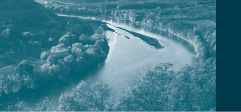Adopt a green infrastructure approach to open space, habitat and water resources
Action
Engineers have developed sophisticated economic models and performance standards for roads, utilities, culverts and other elements of "gray infrastructure." The same level of attention to has not been paid to the capacity of natural systems to perform many vital services.
Advances in modeling and a growing number of successful projects show, however, that reliance on such "green infrastructure" can reduce operating costs and avert the costly side effects "hard solutions." They also give decision makers one more reason to preserve natural resources.
States can benefit in mulitiple ways by aligning open space, habitat and water resource programs to serve, where effective, as green infrastructure. First, green infrastructure allows the integration of inter-related programs such as natural resources management, mapping, parks conservation, floodplain management, and planning. Second, it requires an assessment of the full range of economic value and costs related to land conservation. By presenting a comprehensive picture of costs and benefits, including costs avoided, natural resource and environment departments can serve as stewards of the environment and the state budget at the same time.
Green infrastructure can bolster support for open space preservation. While public support has been high historically, there often is little understanding of the environmental service the land provides. Speaking of open space as part of the "public utility system" strengthens the link between open space and the services it provides, such as clean and dependable water supplies, reduced flooding risks and lower infrastructure costs.
The U.S. Environmental Protection Agency's green infrastructure initiative notes that nature-based systems can supply, protect and filter water, control floods, sequester carbon, preserve habitat and provide recreation. The EPA has issued guidance allowing local and state agencies to use green infrastructure for storm-water runoff and combined sewer overflow. Green infrastructure applies not only to permanently saved open space on National Forest and National Park scale, but also to small watershed restoration projects and the site level use of watershed-friendly landscaping.
Process
Several states have initiated green infrastructure programs by coordinating forestry, Geographic Information Services (GIS) mapping and habitat programs. Other programs related to green infrastructure can include watershed plans, aquifer recharge zones, wellhead protection, stream restoration, Total Maximum Daily Load (TMDL) compliance and carbon sequestration efforts.
One of the first considerations is to align a state's mapping capabilities. The use of GIS and mapping has rapidly expanded, but often these functions are fragmented among various state agencies, universities and the private sector. States can help by designating a one-stop agency, or similarly, a mapping and reporting protocol that allows designated agencies or organizations to create one master map depicting various resources. Recognizing a data clearinghouse as the state's official node for National Spatial Data Infrastructure makes a state eligible for federal grants for GIS development. Once established, this effort could help support a database, land and easement tracking, and a land-banking system.
A next step would be to create an inventory that characterizes land currently designated as open space. Over time, such a program could evolve to track both public and privately held open space. It could also be used to track preservation status, showing for example whether a tract is permanently preserved or under a time-limited easement.
Examples
- Maryland’s Green Infrastructure Program
Maryland’s Green Infrastructure Program is a GIS-based program operated by the Department of Natural Resources that was initially focused on forestland and wildlife habitat. Funding for the Green Infrastructure Program was established as a line item in the state budget. The program consists of two phases: The Green Infrastructure Assessment, which was largely a mapping process, and, the GreenPrint program, which prioritizes and values lands based on which properties support multiple state objectives. Under GreenPrint, the State assesses the relative conservation value of specific parcels offered for sale or easement.
— Maryland’s Green Infrastructure Program - Delaware’s Green Infrastructure Program
In 2003 Governor Ruth Ann Minner signed an executive order on Green Infrastructure that formalized several mapping and planning activities underway. The order, which was launched under the Livable Delaware Program, tied state investment and grant decisions to green infrastructure goals, secured the appointment of a Green Infrastructure Conservation Coordinator within the Department of Natural Resources and Environmental Control to work with all state agencies, provided an inventory of state-owned land, and instituted a green infrastructure strategy to implement the planning effort. The agriculture and natural resources departments also produced a green infrastructure map in 2004, which was incorporated into Delaware’s Wildlife Plan.
— Delaware’s Green Infrastructure Program


